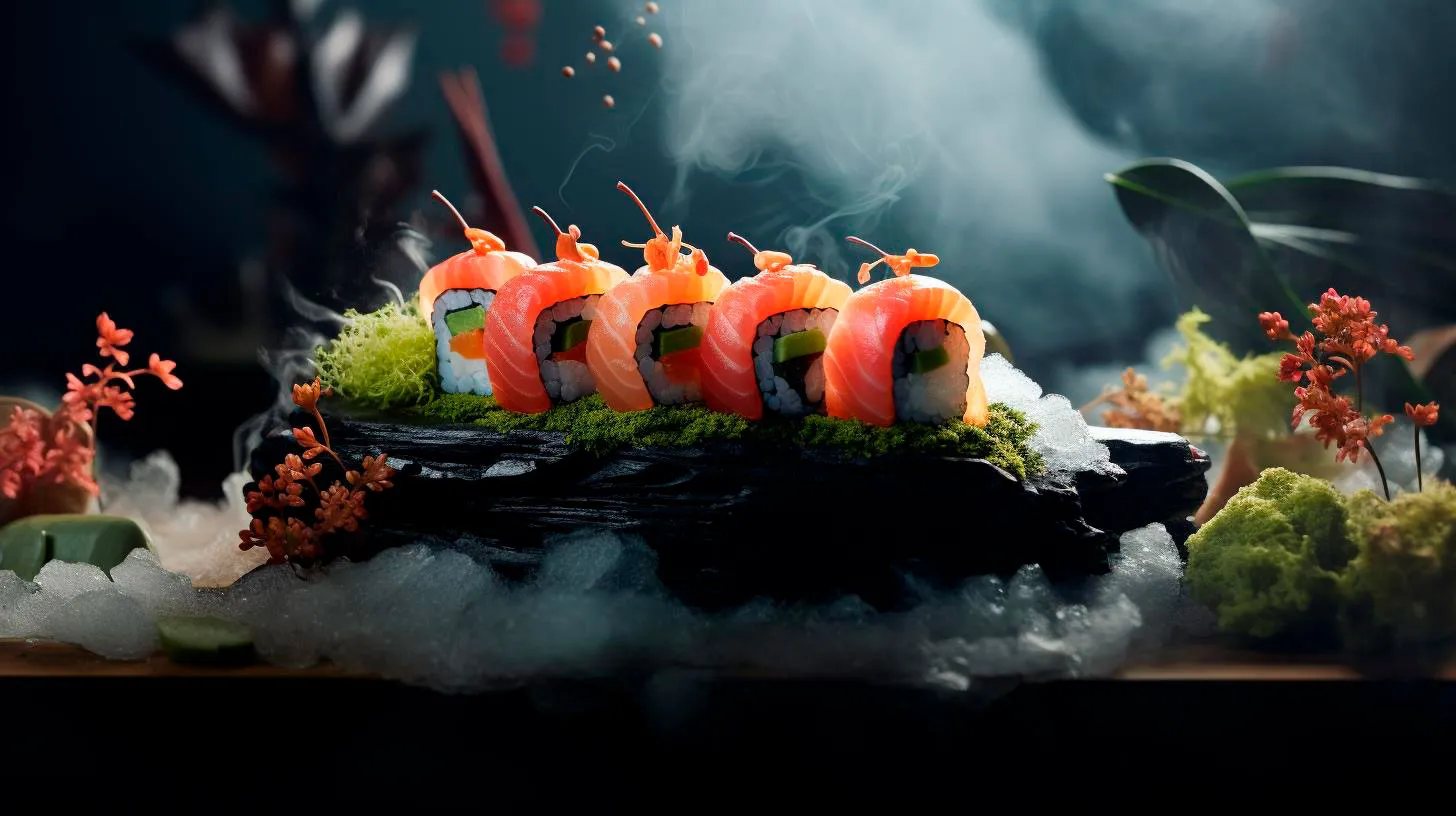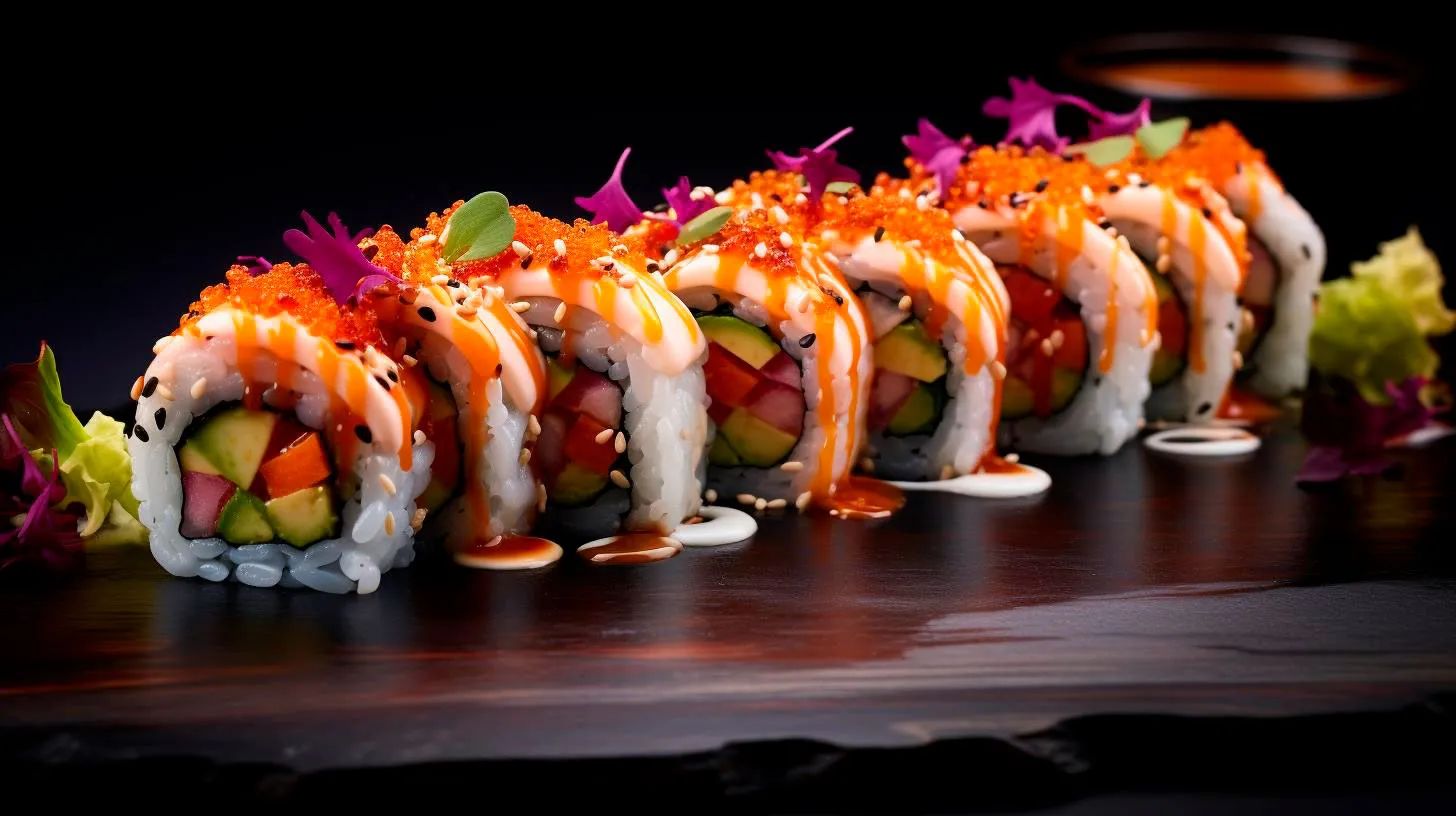Sushi: A Culinary Journey that Transcends Borders
In this article, we will explore the fascinating journey of sushi and delve into the impact of global fusion on its traditional culture.
The Origins and Evolution of Sushi
Sushi has a rich and storied history that can be traced back to ancient Japan. Initially, the purpose of sushi was to preserve fish by fermentation, allowing it to be consumed for extended periods. Over time, sushi evolved as a culinary art form, going beyond mere preservation. Japanese chefs began experimenting with different ingredients and techniques, resulting in the birth of various sushi styles such as nigiri, maki, and sashimi.
As sushi gained popularity within Japan, it started to attract the attention of the international community. Sushi restaurants began popping up in major cities worldwide, catering to both locals and tourists seeking an authentic Japanese dining experience. However, as sushi traveled beyond its borders, it underwent a fascinating transformation, adapting to local tastes and ingredients.
Global Fusion: A Palate-Pleasing Evolution
The globalization of sushi has led to an explosion of creativity and innovation within its traditional culture. Sushi chefs from different countries have begun incorporating local flavors and ingredients into their creations, resulting in the emergence of unique fusion sushi variations. Let’s explore some of the notable impacts of global fusion on sushi culture:
- Ingredients: Local ingredients from different regions are being used to create inventive sushi rolls. For example, the California roll, a popular fusion sushi, substitutes traditional ingredients like raw fish with avocado, cucumber, and crab meat.
- Flavors: Fusion sushi has pushed the boundaries of taste by incorporating flavors from various cuisines. Sushi rolls infused with Thai spices, Mexican salsas, or Indian chutneys offer a delightful explosion of flavors.
- Presentation: Global fusion sushi often takes presentation to new heights, transforming sushi from a simple dish into an art form. Intricately arranged toppings and vibrant colors make for visually stunning plates.
- Accessibility: The fusion of sushi with other cuisines has made it more accessible to individuals who may not typically enjoy raw fish. Vegetarian and vegan options, such as tofu or vegetable rolls, allow a wider range of people to indulge in sushi’s gastronomic pleasures.
The Economic Impact of Sushi
Sushi’s global popularity has had a significant economic impact, both locally and internationally. Consider these compelling statistics:
- Sushi has become a multibillion-dollar industry, with an estimated global market value of over $15 billion by 2023, according to a report by Allied Market Research.
- The United States is the largest consumer of sushi outside of Japan, with Americans consuming over 4 billion sushi rolls each year, as stated by The Washington Post.
- Japan, the birthplace of sushi, sees a constant influx of tourists who travel specifically to indulge in this culinary delight. The Japan National Tourism Organization reports that 24% of foreign travelers visit Japan to experience its unique cuisine.
The Key Takeaways
The fusion of global flavors and techniques with traditional sushi has redefined this beloved culinary art form. Here are the key takeaways:
- Sushi’s journey from its humble beginnings to global recognition showcases its resilience and adaptability.
- Global fusion has introduced innovative flavors, ingredients, and presentations, making sushi a diverse and widely accessible culinary experience.
- The economic impact of sushi highlights its popularity and the immense contribution it makes to local and global economies.
So next time you savor a sushi roll, remember the cultural exchange and culinary finesse that went into creating that delectable masterpiece. Sushi truly embodies the harmonious fusion of tradition and innovation, bringing people together through the universal language of food.
From Tokyo to New York: How Sushi Blends Tradition with Global Flavors
The Evolution of Sushi
Sushi has a rich history that dates back to ancient Japan, where it was primarily a method of preserving fish. Over time, sushi evolved, with chefs experimenting with different toppings, techniques, and flavors. As it made its way to the United States, sushi underwent yet another evolution, adapting to suit local tastes and preferences.
The Fusion of Flavors
One of the standout features of sushi’s journey from Tokyo to New York is the fusion of flavors. Creative sushi chefs in New York have incorporated global ingredients and culinary techniques, resulting in unique flavor combinations and exciting taste experiences. Some of the popular fusion sushi rolls you can find include:
- Spicy Tuna Tempura Roll: A delightful combination of spicy tuna and crispy tempura, creating a satisfying contrast of textures.
- Mexican-inspired Sushi: Incorporating ingredients like avocado, jalapeno, and cilantro adds a refreshing twist to traditional sushi rolls.
- Hawaiian Poke Sushi: A fusion of sushi and Hawaiian poke, featuring marinated raw fish, tropical fruits, and vibrant flavors.
These innovative sushi creations offer diners a taste experience that is both familiar and exciting, allowing them to enjoy traditional sushi with a modern twist.
The Rise of Sushi Culture
Sushi has not only influenced people’s taste buds but has also created a unique dining experience and a way of life. With its emphasis on precision, presentation, and quality, sushi has become synonymous with elegance and sophistication. New York sushi restaurants have adopted this culture, creating a memorable dining experience for their patrons.
Omakase Dining
Omakase, a Japanese term meaning “chef’s choice,” has become a sought-after dining trend in New York. This personalized dining experience allows diners to place their trust in the chef, who selects and prepares a series of courses based on the freshest seasonal ingredients. Omakase dining is a celebration of food and culinary artistry, offering a unique and unforgettable experience for sushi enthusiasts.
The Advantages of Conveyor Belt Sushi
Conveyor belt sushi, also known as kaiten-zushi, has gained popularity in New York due to its convenience and accessibility. This style of sushi dining offers a fun and interactive experience, where diners can choose their favorite dishes from a rotating conveyor belt. It is an excellent option for those looking for a quick and casual sushi fix.
- Convenience: Diners can effortlessly select their desired sushi from the conveyor belt, eliminating the need for ordering through a server.
- Cost-effective: Conveyor belt sushi often offers a more affordable option for sushi lovers, perfect for those on a budget.
- Exploration: The variety of sushi dishes continuously rolling by presents an opportunity for diners to try new and exciting flavors they might not have considered otherwise.
- Efficiency: This sushi dining style ensures a quick turnaround, allowing busy New Yorkers to enjoy a satisfying meal without sacrificing time.
Key Takeaways
Sushi’s journey from Tokyo to New York has been nothing short of remarkable. The fusion of traditional Japanese techniques with global flavors has brought about a vibrant and diverse sushi culture. Alongside innovative sushi rolls, the rise of omakase dining and the popularity of conveyor belt sushi has revolutionized the way people enjoy this beloved cuisine.
Whether you are a sushi connoisseur or a curious newbie, exploring the world of sushi in New York promises to be an exciting adventure. With its rich flavors, artistic presentation, and unique dining experiences, sushi continues to captivate food lovers worldwide.
The Evolution of Sushi: Cross-Cultural Influences and Adaptations
In this article, we will explore the intriguing journey of sushi, its cross-cultural influences, and how it has become a global gastronomic phenomenon.
A Brief History of Sushi
Sushi originated in Southeast Asia over 2,000 years ago as a means to preserve fish by fermenting it with rice and salt. This early form of sushi was called narezushi and was quite different from the sushi we know today. The fermented fish was often discarded, and only the rice was consumed. It wasn’t until the 17th century that a new method emerged, known as haya-zushi, where fish and rice were consumed together. This marked the birth of modern sushi.
The Edo period in Japan (1603-1868) saw sushi gain popularity in Tokyo, then known as Edo. Street vendors began selling small portions of sushi, packed in wooden boxes, as a quick and convenient snack. In the mid-19th century, a culinary revolution occurred when Yohei Hanaya, a sushi chef, introduced nigiri-zushi. This style of sushi consisted of small hand-pressed rice topped with a slice of fresh fish, creating a more flavorful and visually appealing dish. Nigiri-zushi quickly became a sensation, laying the foundation for the sushi we enjoy today.
Sushi Goes Global
As Japan opened up to the rest of the world in the late 19th century, cultural exchange and trade brought sushi to international shores. In the early 20th century, Japanese immigrants began migrating to the United States, particularly California, in search of opportunities. The introduction of sushi to California was a turning point in its culinary journey. Initially, sushi was met with skepticism and unfamiliarity, but as Japanese communities grew and flourish, sushi gradually gained acceptance.
The sushi boom in the United States occurred in the 1960s and 1970s, propelled by cultural changes and growing interest in international cuisines. It was during this period that sushi began to undergo significant adaptations to cater to American tastes. To suit the preferences of the Western audience, new forms of sushi were created, such as the famous California roll. This roll substituted traditional raw fish with cooked ingredients, making it more appealing to those hesitant to try raw seafood.
Today, sushi has become a ubiquitous culinary delight. It can be found in numerous countries across the globe, each incorporating their own unique touch. From the fusion-inspired sushi of Brazil to the innovative sushi creations in Australia, sushi has embraced cross-cultural influences and adapted to local tastes.
Key Takeaways
- Sushi originated in Southeast Asia and evolved over centuries in Japan.
- Nigiri-zushi, featuring hand-pressed rice topped with fresh fish, revolutionized sushi during the Edo period.
- Japanese immigrants introduced sushi to the United States, leading to its popularization worldwide.
- Adaptations like the California roll helped sushi gain acceptance in Western countries.
- Sushi has now become a global phenomenon, with each country adding its own unique twist.
In conclusion, the evolution of sushi is a testament to the power of cross-cultural influences and adaptations. From its early beginnings as a preservation technique to its current global popularity, sushi has continuously reinvented itself to suit diverse palates and preferences. Whether you enjoy traditional nigiri-zushi or experiment with fusion rolls, sushi offers a culinary journey that transcends borders and unites people through their love of exquisite flavors. So, the next time you savor a piece of sushi, remember the remarkable journey it has taken to reach your plate.



